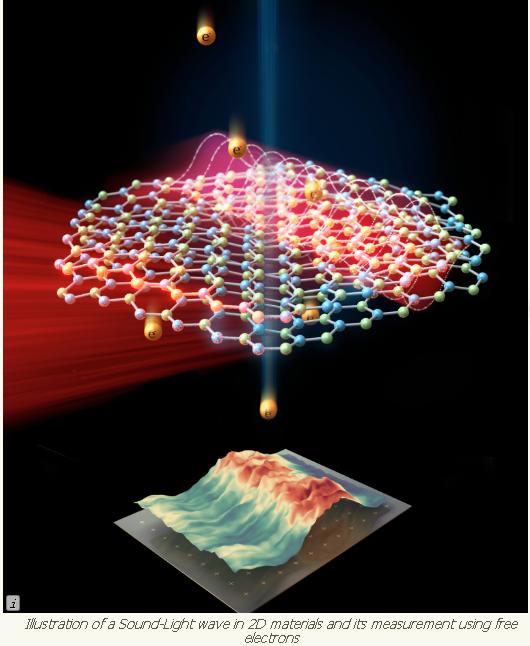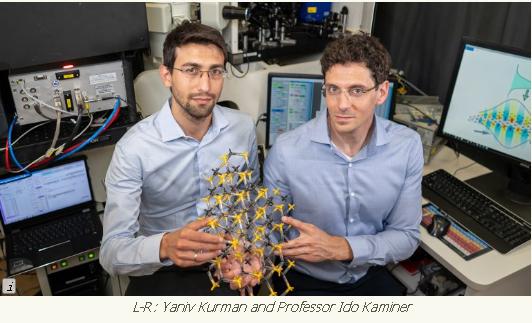博文
研究人员首次在2D材料中观察到声光脉冲
 精选
精选
||
研究人员首次在2D材料中观察到声光脉冲
诸平

Credit: CC0 Public Domain



以色列理工大学(Technion - Israel Institute of Technology)2021年6月11日报道,以色列理工大学的研究人员使用超快透射电子显微镜(ultrafast transmission electron microscope),首次记录了在原子薄材料中声波和光波的组合传播。这些实验是在罗伯特和露丝·马吉德电子束量子动力学实验室(Robert and Ruth Magid Electron Beam Quantum Dynamics Laboratory)进行的,该实验室由安德鲁和厄娜维特比电气与计算机工程学院(Andrew and Erna Viterbi Faculty of Electrical & Computer Engineering)和固体研究所(Solid State Institute)的伊多·卡米纳教授(Professor Ido Kaminer)领导。
单层材料,也被称为二维(2D)材料,本身是一种新型材料,是由一层原子组成的固体。石墨烯是首次发现的2D材料,于2004年首次分离出来,这一成就获得了2010年的诺贝尔物理学奖(The Nobel Prize in Physics 2010)。现在,Technion的科学家们第一次展示了光脉冲是如何在这些材料中移动的。相关研究结果于2021年6月11日已经在《科学》(Science)杂志网站发表——Yaniv Kurman, Raphael Dahan, Hanan Herzig Sheinfux, Kangpeng Wang, Michael Yannai, Yuval Adiv, Ori Reinhardt, Luiz H. G. Tizei, Steffi Y. Woo, Jiahan Li, James H. Edgar, Mathieu Kociak, Frank H. L. Koppens, Ido Kaminer. Spatiotemporal imaging of 2D polariton wave packet dynamics using free electrons. Science, 11 Jun 2021, 372(6547): 1181-1186. DOI: 10.1126/science.abg9015. https://science.sciencemag.org/content/372/6547/1181
参与此项研究的除了色列理工学院的研究人员之外,还有来自西班牙巴塞罗那理工学院(Barcelona Institute of Science and Technology)、法国巴黎-萨克雷大学 (Université Paris-Saclay)以及美国堪萨斯州立大学(Kansas State University)等单位的研究人员。
光以每秒30万km的速度在太空中移动。当它在水中或玻璃中移动时,速度会下降一小部分。但当光穿过几层固体时,速度会减慢近千倍。这是因为光使这些特殊材料的原子振动产生声波,也称为声子(phonons),而这些原子声波振动时产生光。因此,此脉冲实际上是声和光的紧密结合,称为“声子极化子(phonon-polariton)”。所以,此脉冲既能使材料亮起来,又会使材料“唱歌”。
科学家们沿着一种2D材料的边缘发出光脉冲,在这种材料中产生混合声光波(hybrid sound-light waves)。他们不仅能够记录这些波,还发现此脉冲可以自发地加速或减速。令人惊讶的是,这些波甚至分裂成两个单独的脉冲,以不同的速度移动。
实验采用超快透射电子显微镜(ultrafast transmission electron microscope简称UTEM)进行。与光学显微镜和扫描电子显微镜相反,在这里粒子穿过样品,然后被探测器接收。这一过程使研究人员能够在空间和时间上以前所未有的分辨率追踪声光波(sound-light wave)。时间分辨率是50飞秒(50×10-15秒)。
上述论文的第一作者亚尼夫·库曼(Yaniv Kurman)解释说:“混合波在材料内部移动,所以你不能用普通的光学显微镜观察到它。大多数2D材料的光测量是基于显微镜技术,使用针状物体逐点扫描表面,但每一个这样的针接触干扰了我们试图成像的波的运动。相比之下,我们的新技术可以成像光的运动而不会使其运动受到干扰。我们的结果不能用现有的方法得到。所以,除了我们的科学发现之外,我们还展示了一种以前看不见的测量技术,它将与更多的科学发现相关联。
本研究诞生于COVID-19流行的高峰期。在学校关闭的几个月里,伊多·卡米纳教授实验室的研究生亚尼夫·库尔曼(Yaniv Kurman)坐在家里进行数学计算,预测光脉冲在2D材料中的表现,以及如何对其进行测量。与此同时,该实验室的另一名学生拉斐尔·达汉(Raphael Dahan)意识到如何将红外脉冲聚焦到小组的电子显微镜中,为实现这一目标并进行了必要的升级改造。封锁一结束,小组就能够证明亚尼夫·库尔曼的理论,甚至揭示了他们没有预料到的其他现象。
虽然这是一项基础科学研究,但科学家们希望它能有多种研究和工业应用。伊多·卡米纳教授说:“我们可以用这个系统来研究不同的物理现象。我们计划进行测量光的漩涡实验、混沌理论的实验以及对黑洞附近现象的模拟。此外,我们的发现可能允许制造原子级纤薄光纤‘电缆’,这种光缆可以放置在电路中,在不使系统过热的情况下传输数据。由于电路最小化,这一任务目前面临着相当大的挑战。”
该团队的工作启动了一组新型材料内部光脉冲的研究,拓宽了电子显微镜的能力,并促进了通过原子薄层进行光通信的可能性。
来自斯图加特大学(University of Stuttgart)的哈拉尔德·吉森教授(Professor Harald Giessen),他并没有参与此项研究,但是他对此评价说:“我对这些发现感到很激动,这代表了超快纳米光学的真正突破,代表了科学前沿的艺术水准。在真实空间和实时的观察是美丽的,据我所知,这是以前没有被证明过的。”
另一位没有参与这项研究的著名科学家,来自美国麻省理工学院(Massachusetts Institute of Technology)的John Joannopoulos补充说:“这一成就的关键在于巧妙的设计和实验系统的开发。伊多·卡米纳及其团队和同事的这项工作是向前迈出的关键一步。它在科学和技术上都具有重大意义,对该领域具有至关重要的意义。”上述介绍仅供参考,欲了解更多信息敬请注意浏览原文或者相关报道。
Two-dimensional (2D) materials can confine light to volumes much shorter than the wavelength, and, together, the long propagation lengths make them attractive materials for developing nanophotonic platforms. Characterizing the spatiotemporal control of 2D polariton wave packets has been hindered for the same reasons that make their potential applications exciting: They have extremely small wavelengths and are strongly confined inside the material. Kurman et al. developed a new pump-probe technique based on electron emission that provides access to the spatiotemporal dynamics of 2D polaritons. The nanometric spatial resolution and femtosecond temporal resolution will be useful for probing the excitation dynamics of these materials.
Science, abg9015, this issue p. 1181
Coherent optical excitations in two-dimensional (2D) materials, 2D polaritons, can generate a plethora of optical phenomena that arise from the extraordinary dispersion relations that do not exist in regular materials. Probing of the dynamical phenomena of 2D polaritons requires simultaneous spatial and temporal imaging capabilities and could reveal unknown coherent optical phenomena in 2D materials. Here, we present a spatiotemporal measurement of 2D wave packet dynamics, from its formation to its decay, using an ultrafast transmission electron microscope driven by femtosecond midinfrared pulses. The ability to coherently excite phonon-polariton wave packets and probe their evolution in a nondestructive manner reveals intriguing dispersion-dependent dynamics that includes splitting of multibranch wave packets and, unexpectedly, wave packet deceleration and acceleration. Having access to the full spatiotemporal dynamics of 2D wave packets can be used to illuminate puzzles in topological polaritons and discover exotic nonlinear optical phenomena in 2D materials.
https://blog.sciencenet.cn/blog-212210-1291026.html
上一篇:天文学与病理学相结合,确定癌症免疫治疗的预测性生物标志物
下一篇:diABZI-4:潜在抗COVID-19病毒化合物